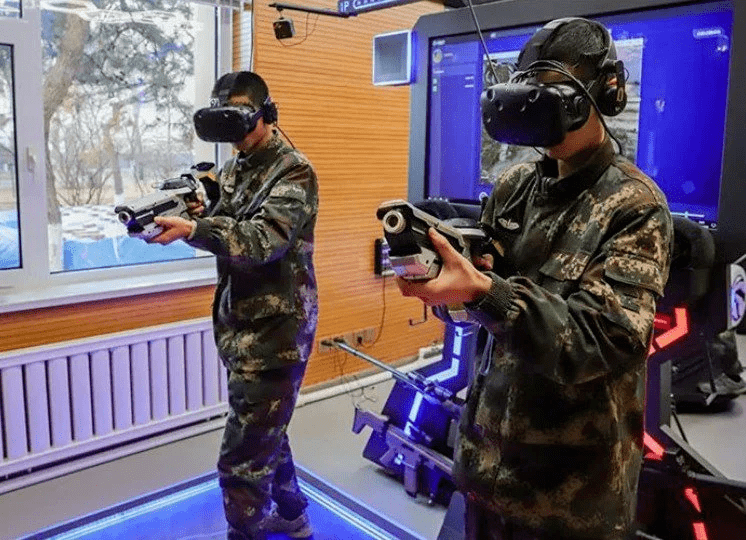What use case is there for the Military?
The US Military is building a new Metaverse for their Troops to train. For example, the Air force has already started using Metaverse applications for their pilots. In addition, the Army works with Microsoft on its own program.
In may 2022, two fighter pilots performed a high-altitude proto-metaverse (MV) experiment. A few thousand feet above the desert of California, in a pair of Berkut 540 jets, they donned custom AR headsets to connect to a system that overlaid a ghostly, glowing image of a refueling aircraft flying alongside them in the sky. One of the pilots then performed a refueling maneuver with the virtual tanker while the other looked on. Welcome to the fledgling military metaverse (MV).
It isn’t only Silicon Valley that’s gripped by metaverse (MV) mania these days. Just as tech companies and corporations are scrambling to develop strategies for virtual worlds, many defense startups, contractors, and funders are increasingly talking up the metaverse (MV).
What is needed for this Metaverse?
The key technologies needed for the metaverse (MV) are augmented and virtual reality, head mounted displays, 3D simulations and virtual environments built by artificial intelligence. This is already found in the defense world. A mix of augmented reality, artificial intelligence, and video game graphics, for instance, have enabled fighter pilots to practice dogfighting against virtual opponents. For instance, including Chinese and Russian warplanes, while pulling several Gs.
Red 6, the company that’s developing the technology, says this delivers a far more realistic test of a pilot’s abilities than a conventional flight simulator. “We can fly against whatever threat we want,” says Daniel Robinson, founder and CEO of Red 6. “And that threat could be controlled either by an individual remotely or by artificial intelligence.”
Red6’s AR technology has to work in more extreme conditions, with lower latency and higher reliability than consumer AR or VR headsets. Robinson adds that the company is now working on a platform that will allow many different scenarios to be represented in augmented or virtual reality. “What we’re building is really a military metaverse,” he says. “It’s like a multiplayer video game in the sky.”
How else is the Metaverse used?
Metaverse-related ideas are already part of some of the latest military systems. The high-tech helmet for the new F-35 fighter jet, for instance, includes an augmented reality display that shows telemetry data and target information on top of video footage from around the aircraft. In 2018, the US Army announced that it would pay Microsoft up to $22 billion to develop a version of its HoloLens augmented reality system for warfighters, known as the Integrated Visual Augmentation System (IVAS).
VR and AR have become routine aspects of military training in recent years. In 2014, the Office of Naval Research and the Institute for Creative Technologies at the University of Southern California developed Project BlueShark. This system allows sailors to drive vessels and collaborate in a virtual environment. Another effort, called Project Avenger, is now used to help train US Navy pilots. The US Air Force is using VR to teach pilots how to manage aircraft and missions. VR is also used to help treat veterans for chronic pain and post-traumatic stress. And Boeing has created an AR environment that lets mechanics practice working on planes before stepping aboard a real one.

Recently, the US military has begun exploring more complex virtual worlds.
There is also growing interest in connecting and combining virtual worlds in a way that resembles metaverse thinking. In December 2021, the US Air Force held a high-level conference involving over 250 people in locations stretching from the US to Japan, via a virtual environment. “The promise is integrating these technologies,” says Caitlin Dohrman, general manager of the defense division of Improbable.
A company that develops virtual world technologies, has created sprawling virtual battlefields featuring over 10,000 individually controlled characters for the UK’s military wargames. Also works with the US Department of Defense (DOD). “It is an extremely complex type of simulation, especially given the fidelity that the military demands,” Dohrman says. “You can either have live players who are participating in the simulation or [characters] can be AI-enabled, which is often what the military does.”
How much of this cutting-edge tech makes it to the front line?
In 2017, Luckey co-founded the defense company Anduril. He says that despite all the recent metaverse hype, there is big defense potential, partly because military training is so important and costly. But he says the technology does not have to be hyper-realistic to be useful, and he wants Anduril to focus on only using the technology where necessary. “Everything we’re doing with VR is something where it is uniquely better than any other option,” he says. This includes using VR to train people to operate Anduril’s drones, he says, or to display information about an area using data from sensors on the ground.
But how much of this cutting-edge tech makes it to the front line—or even into training exercises—remains unclear. Sorin Adam Matei, a professor at Purdue University in West Lafayette, Indiana, who has developed virtual battlefield training platforms for the US military, says the tech deployed will often be considerably simpler than metaverse boosters imagine. He suggests that a simpler version of the IVAS headset may eventually be integrated into an AR rifle scope. “When you are out there shooting and being shot at, the last thing you want to worry about is another piece of equipment,” he says. And technology does not need to be as expansive as a metaverse to be useful. “We need to think a bit more about this metaverse metaphor—which is powerful but also has its limitations.”